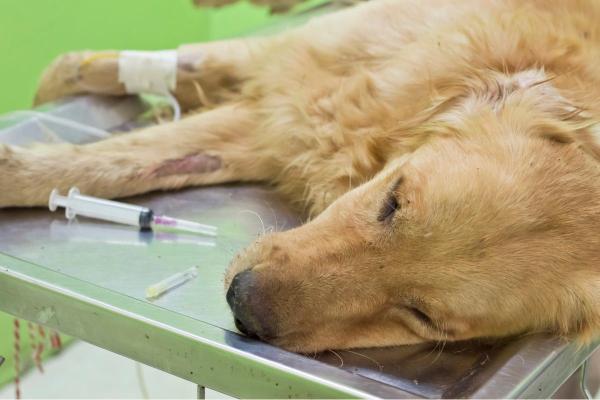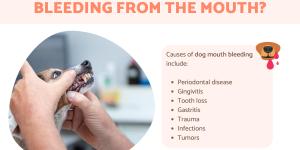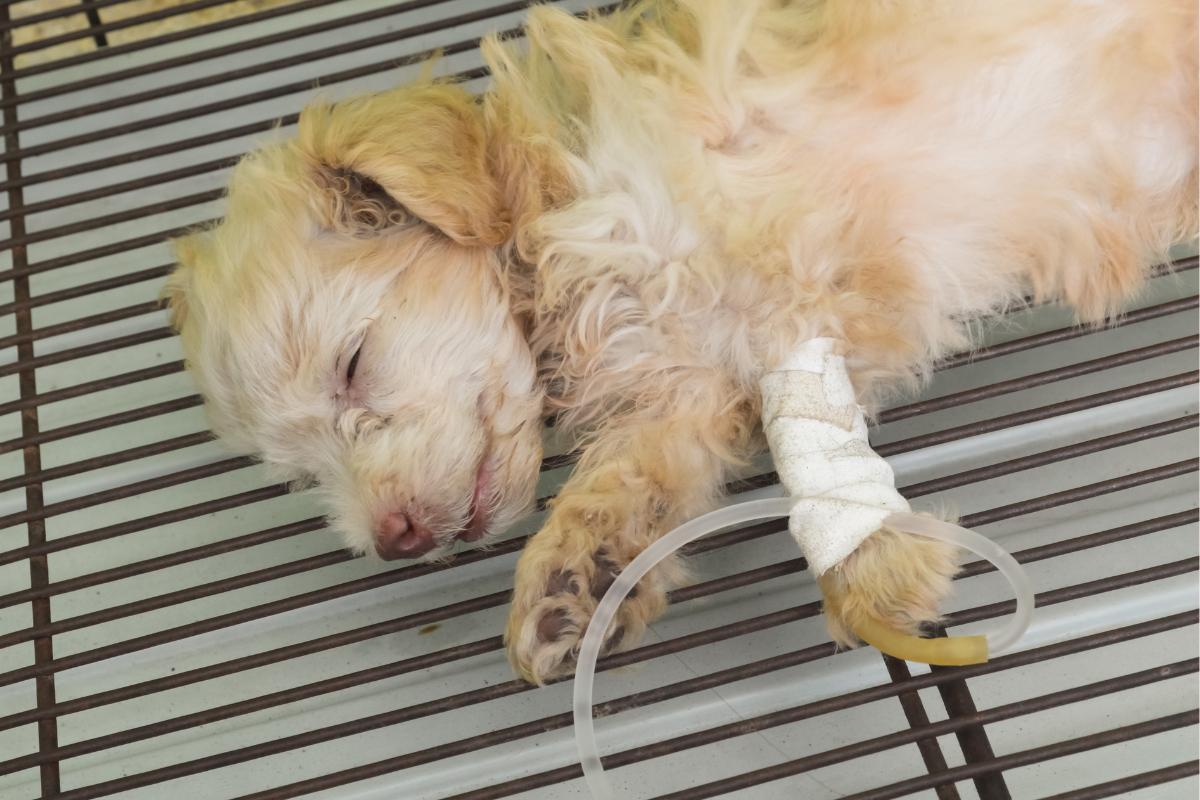Internal Bleeding in Dogs - Signs and Treatment



See files for Dogs
Internal bleeding in dogs can be difficult to diagnose since the problem lies with tissues we cannot observe directly. Often the signs of the internal hemorrhage are systemic since the internal blood loss will affect the functioning of the dog's organism greatly. Although the direct cause of internal bleeding is a rupture of the blood vessels, this can be a result of various problems. Physical trauma is one of the most common, even if we do not see any injuries. It is also possible inherited or acquired diseases can cause internal bleeding, among others.
At AnimalWised, we look at the signs and treatment of internal bleeding in dogs. We look at how to support the dog when taking them to an emergency veterinary clinic, as well as what we can expected in terms of stopping the dog's internal bleeding.
What is internal bleeding in dogs?
Bleeding occurs when a blood vessel ruptures. This can be a capillary, a vein or an artery, the smallest-to-largest sizes of blood vessels. The bleeding can be superficial or internal. When vessels in the skin are cut, punctured or lacerated, a hemorrhage occurs. If only external tissue is damaged, it is rarely fata. The problem is when the bleeding is internal, i.e. the extravasated blood is contained in a body cavity and a guardian cannot observe it directly.
The main risk of internal bleeding in dogs is hypovolemic shock. This occurs when the body runs out of blood in the blood vessels, unable to deliver oxygen to the cells. It can lead to the death of the animal. Hypovolemic shock caused by hemorrhage is established with blood loss equal to 30% of the volume in the dog. If the dog loses around 30% of its blood volume, its body will go into shock.
Causes of internal bleeding in dogs
As explained above, capillaries, veins and arteries can break or leach, leading to an internal hemorrhage. It is this which is the direct cause of the internal bleeding, but there are various situations which can lead to blood vessel rupture:
- Trauma: physical trauma to the vessel is one of the most common causes of internal bleeding in dogs. Even though the external tissue does not look damaged, a traffic collision, fall or even physical abuse can cause these internal structures to rupture. These are particularly worrying in areas such as the head, thorax and abdomen since this is where vital organs are located.
- Neoplasms: neoplasms are the overproliferation of cells which results in a mass developing. This can be benign in the form of canine lipoma or cysts, but they can also be cancerous. Although cancerous tumors are more dangerous and require specific treatment such as chemotherapy for dogs, even benign neoplasms can cause internal bleeding. This occurs when the growth of the mass damages the blood vessels.
- Medications: certain strong medications can cause internal bleeding. An example is some non-steroidal anti-inflammatory drugs (e.g. dexketoprofen for dogs) which can result in damage to the stomach and the rupture of blood vessels. Also, blood thinners or anticoagulants can cause internal bleeding if not administered appropriately.
- Disease: various inherited or acquired diseases can result in internal bleeding in dogs. This includes hemophilia which prevents blood clotting correctly. Colitis or other inflammation can also cause internal bleeding. If a female dog is bleeding from her vagina, it could be due to a problem such as endometriosis in dogs.
Due to their activity and excitement levels, younger dogs are more likely to develop internal bleeding from trauma. Older dogs are more likely to suffer neoplasms such as tumors since their body's defenses are worn down by age.
Symptoms of internal bleeding in dogs
Internal bleeding in dogs is a worrying condition that can have different symptoms. This is why it is so important to pay attention to the signs that indicate the presence of internal bleeding. An early diagnosis can save the life of the dog. Dogs with internal bleeding present the following general symptoms:
- Weakness
- Pale mucous membranes (e.g. pale gums)
- Cold skin
- Dizziness
- Thirst
- Agitated breathing
- Vocalizations indicating discomfort
- Pain
- Loss of consciousness
Never try to treat the dog at home on your own. Internal bleeding is a medical emergency that must be attended to by a professional as soon as possible.
Is defecating blood a symptom of internal bleeding in dogs?
When a dog is passing blood with their stool, many guardians wonder if this could be a sign of internal bleeding. This can be a symptom of internal bleeding in the animal. After trauma, depending on the region affected, the dog may urinate or defecate blood. This is because some of the blood vessels in organs such as the bladder and intestines can break, causing bleeding. This symptom can be a very useful indicator to detect bleeding caused by a hit-and-run, for example.
However, this does not mean a dog has internal bleeding if you see some blood in their stool. In fact, if you see fresh blood, it means there is a problem in the very lower part of the gastrointestinal tract. If internal bleeding of the organs occurs, the blood that is defecated will be darker due to partial digestion in the gut.
In addition, certain gastrointestinal pathologies may be causing the internal bleeding. While these are serious on their own, it doesn't mean they are necessarily life threatening at this stage. Internal parasites in the dog may also cause problems such as blood in the dog's stool. Regardless of the cause of bleeding, a veterinary assessment must be carried out. Any cause of bleeding must be determined and addressed appropriately.
Consequences of internal bleeding in dogs
Internal bleeding is a very serious condition in dogs that can lead to death of the dog if not stopped in time. The hemorrhage can progress to hypovolemic shock, characterized as an emergency condition in which severe blood and fluid loss results in a critical decrease in blood volume. This renders the heart unable to pump enough blood to the tissues.
Abdominal hemorrhages in dogs should receive intense fluid therapy to stabilize the animal. Surgical intervention will be required if the animals undergoing clinical treatment do not show improvement in their condition.
Learn more about serious problems such as internal bleeding with our article on symptoms a dog is dying.

What to do if my dog has internal bleeding
If you suspect your dog has internal bleeding, lay them down in a comfortable position and keep them warm. You can do so using a blanket or a hot water bottle. Do not try to fix the problem yourself and do not delay. Seek assistance immediately.
Take the dog immediately to a trusted veterinary clinic. Avoid moving the animal as this can worsen internal bleeding. During the journey, check the dog's vital signs such as the temperature and the color of the gums. These observations can help the vet during the consultation, along with the history of trauma that may have caused the bleeding.
Internal bleeding in dogs treatment
Once at the veterinary clinic, it will be necessary for you to provide the veterinary professional all the information you can. This includes the possible cause of the bleeding, the state of their mucous membranes, the symptoms they present, etc. To stop internal bleeding in the dog, the vet can administer different treatments such as:
- Fluid therapy
- Blood transfusions
- Oxygen
- Surgery
Once the internal bleeding has been stopped, its underlying cause can be assessed and treated. Depending on said cause of the bleeding, specific medications will be administered, but at no time should you try to self-medicate your dog at home.
Now that you know the causes, symptoms and treatment of internal bleeding in dogs, you can take a look at the video below which details some of the main symptoms which indicate a dog is dying:

This article is purely informative. AnimalWised does not have the authority to prescribe any veterinary treatment or create a diagnosis. We invite you to take your pet to the veterinarian if they are suffering from any condition or pain.
If you want to read similar articles to Internal Bleeding in Dogs - Signs and Treatment, we recommend you visit our Other health problems category.
- Santos, S. M. J., et al. (2020). Cartilha de primeiros socorros: haemorrhages. Card linked to the group of studies and research on the health of people in critical conditions – UFPB. Retrieved fromt: http://www.ccta.ufpb.br/editoraccta/contents/titulos/saude/cartilha-de-primeiros-socorros-hemorragias/cartilha-hemorragia.pdf
- Zancan, R. G. (2014). Fluid therapy not hypovolemic shock. Retrieved from: https://repositorio.ufsm.br/bitstream/handle/1/779/Zancan_Rubia_Gabriela.pdf?sequence=1
- Sardinha, M. R. R. (2015). Retrospective Study of Hemoabdómen in Cães. Retrieved from: https://core.ac.uk/download/pdf/48584231.pdf






